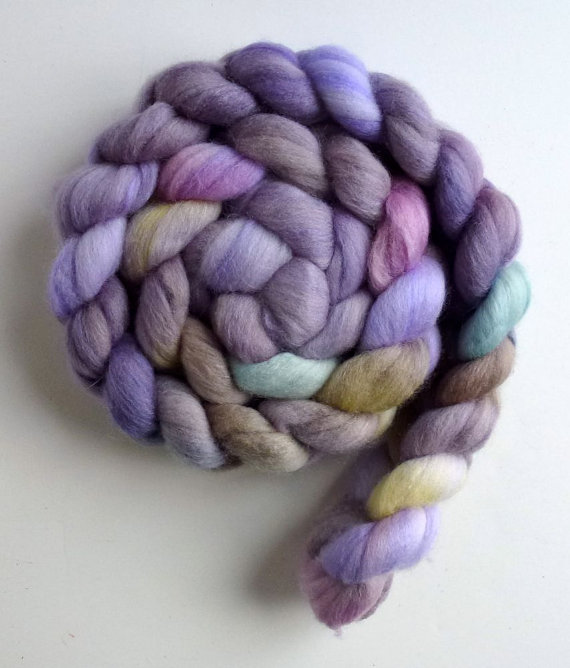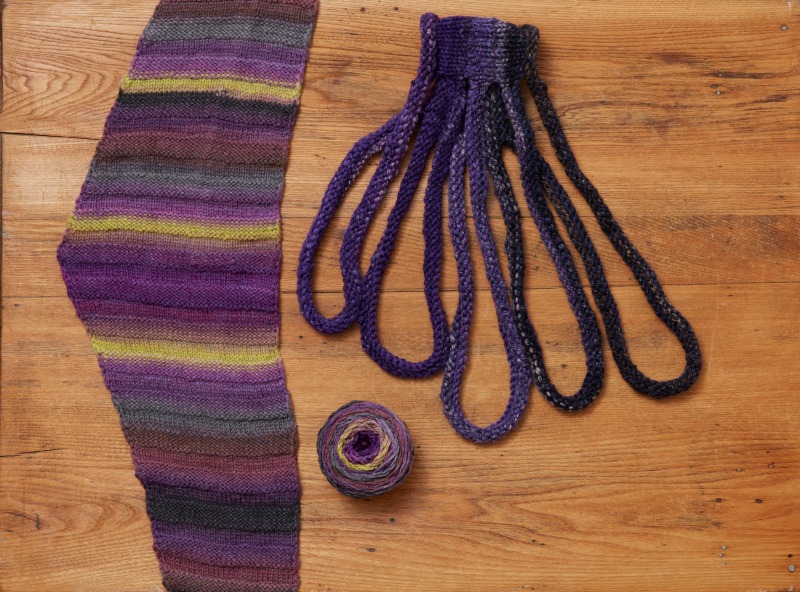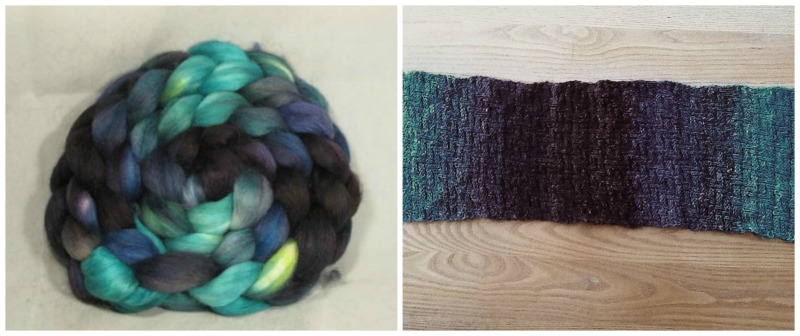Does your fiber stash look anything like mine? Boxes, bags, and baskets overflow with raw washed fleece (waiting to be processed); “mix-ins” such as cut-up sari silk, angora rabbit samples, handfuls of colored top, and small amounts of what I like to call blending fibers (waiting to be mixed in); batts and birds’ nests (waiting to be spun); and braid after braid of handpainted top. Seriously, why do I have so many braids? BECAUSE I LOVE THEM. When I want to focus on spinning rather than prep and/or I feel even lazier than usual, I indulge myself by spinning handpainted roving. Somebody else took some ready-to-spin fiber—maybe in an exotic blend—and worked out the colors. All I have to do is spin.
If only it were that easy! These braids, like variegated yarns, seduce me with their glorious hues. But handpainted roving can lose some of its beauty unless I think about how those colors will translate into yarn. I can always spin a single-ply yarn if I want to keep the colors pure; in the past, that solution worked well enough (plus, it suited my laziness). But these days, I prefer to make and knit with multi-ply handspun, which complicates yarn design—and that’s not a bad thing. When we start playing with yarn design, we gain a deeper understanding of spinning.
When I spin in color with handpainted roving, 2 essential questions drive the project: Do I want the colors to blur together or remain distinct? And how will the number of plies change how the colors turn out? With braids, I rarely choose a knitting pattern ahead of time. Doing so would add another question: How will the resulting yarn look in my chosen project?
Several projects from a few years ago show where my spinning decisions worked and where they didn’t. Only 1 out of 7 spinning projects failed to thrill because of my choices.
Top, Lisanthus shawlette; bottom, Fangorn wrap.
Blurry Colors
- Fangorn wrap, 2012. Sometimes I buy things based on color names, not just color combos. Corgi Hill Farm created a luscious colorway called Fangorn Forest—I’m pretty sure they did this just to ensnare hobbits. I spun about 10 ounces into a 2-ply yarn with no attempt to line up colors. Then I knitted Susan Pandorf’s Treebeard Shoulder Wrap (though I didn’t sew mine into a circle), because Tolkien nerd. Although the colors seemed thoroughly blended in the skein, they created fairly regular bands in a highly textured knitted fabric.
- Lisianthus shawlette, 2013. I used a similar spinning approach on a beautiful pastel braid from Three Waters Farm: 2-ply yarn with no attempt to line up colors. There was just enough yarn to knit Jennifer Dassau’s lovely Rufflebye shawl. Here, however, I regretted my spinning choices. Shades of yellow got buried in all the lavender tones. If I’d split the braid in half lengthwise before spinning and lined up colors even a little, I would have been happier. Imagine the shawl’s “wings” with more pronounced yellow stripes!
Three Waters Farm, “Lisianthus” colorway. Photo used by kind permission of Three Waters Farm.
Distinct Colors
- Sev-circle cowl, 2012. An ombré braid from Corgi Hill Farm became a singles that I Navajo-plied. The resulting Aran-weight 3-ply yarn shaded from medium violet to deep purple. Since there wasn’t much yardage, I chose a small accessory and still ran out! Kirsten Johnstone’s sev[en]circle cowl shows off the gradient colors beautifully.
Left, Wavy Waves scarf; right, Sev-circle cowl.
- Wavy Waves scarf, 2013. Purples and yellows dappled the handpainted roving from Three Waters Farm. Here I wanted pure colors. I’d planned a 2-ply yarn, but somehow the colors didn’t line up—probably I started from the opposite end of the braid on the second bobbin. So I Navajo-plied most of the yarn, resizing loops as I worked to create relatively sharp breaks between colors. That was a good choice: once I started knitting Frollein Rosenresli’s Wellenbaktus, I could see how distinct vertical stripes would appear—just what I wanted!
Left, Wingspan shawlette; right, Legolas scarflette.
- Legolas scarflette, 2013. A Three Waters Farm braid in shades of blue-green made a gorgeous 2-ply yarn with the colors lined up. Then I knitted Susan Pandorf’s Legolas Kerchief: This is the scarflette I’m wearing in my editor’s photo (in Love of Knitting) and my Ravatar.
- Wingspan shawlette, 2013. Another great Three Waters Farm dyejob, spun fine, Navajo-plied, and knitted with the wildly popular Wingspan pattern by Maylin of Tricoterie Designs.
- Darkside Scarf, 2013. More of Corgi Hill Farm’s Fangorn Forest colorway, because my stepmother loved the colors. This time, I tried to keep colors pure, creating a 2-ply and a Navajo-plied 3-ply. The resulting yarn got knitted up into Sarah Fama’s Darkside Cowl (okay, a scarf) and mittens.
Corgi Hill Farm, “Fangorn Forest” colorway, worked out well in blurry and pure colors. It became the Fangorn wrap (blurry) and Darkside scarf (pure). Braid photo used by kind permission of Corgi Hill Farm.
What did I learn from spinning and knitting these projects?
Spinning handpainted roving:
- Two-ply yarn works for blended colors. For pure colors, it can work if I split the braid and then spin each bobbin starting from the same end of the roving. Make notes or take pictures, Deb!
- Navajo plying always works. If I want distinct colors, I can micromanage the loops; for blended shades, I can ply with abandon. Anne Merrow, editor of Spin Off, also recommends corespinning to keep colors distinct. I haven’t tried this yet.
Knitting variegated yarns:
- Pure-color yarns within the same color family or within a family and its close relatives can handle texture patterns and simple lace. If the colors zip across the color wheel, however, stick to garter or stockinette—anything busier might not work so well.
- The same principle holds true for blended-color yarns: first-cousin colors can hold their own in a busy pattern, but more distant relations need simple stitches.
- Short-row designs work amazingly well for blended or pure colors.
If you’ve ever struggled to find knitting patterns for multicolored yarns, or if you’ve avoided such yarns because you don’t know what to do with them, Love of Knitting ran a series of articles on color in 2015 and 2016. We also devoted Love of Knitting Spring 2017 to color, including great designs for variegated yarns, stripes, and other color combinations.
—Deb







